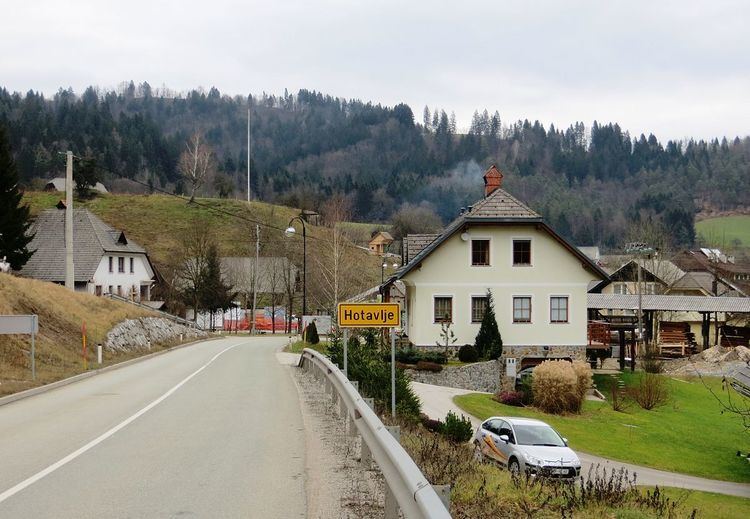Area 4.14 km² Population 353 (2002) | Elevation 445 m Local time Wednesday 6:13 AM | |
 | ||
Weather 1°C, Wind NW at 0 km/h, 88% Humidity Municipality | ||
Hotavlje ([xɔˈtaːu̯ljɛ]; in older sources also Hotovlje, German: Hotaule) is a village in the Poljane Sora Valley in the Municipality of Gorenja Vas–Poljane in the Upper Carniola region of Slovenia.
Contents
- Map of 4224 Hotavlje Slovenia
- Geography
- Quarries
- Name
- History
- Church
- Other cultural heritage
- Notable people
- References
Map of 4224 Hotavlje, Slovenia
Geography
Hotavlje lies in a narrow valley above the outflow of Hotaveljščica Creek (an alternate name applied after the confluence of Kopačnica Creek with Volaščica Creek) into the Poljane Sora. Homovšak Creek joins Hotaveljščica Creek further downstream, near Saint Lawrence's Church. Hotavlje primarily lies along the road north to Kopačnica. The valley itself is damp, and the surrounding slopes have a shale and limestone composition. Vranšek Hill (Slovene: Vranškov grič; 908 meters or 2,979 feet) rises above the village to the west.
Quarries
Hotavlje is best known for its stone quarries, which started operating in the mid-19th century. Cordevolian limestone (marketed as Cordevol limestone, also referred to as hotaveljski marmor 'Hotavlje marble') is a greyish-pink and red mineral. It has an attractive mottled appearance with irregular patches of grey, opaque yellow, or scarlet dolomite in small rhomboid crystals, white and coloured calcite veins, and frequent remnants of fossilised algae. Its colour and the high gloss of its polished surface make it a popular material and it was traditionally used in buildings in the area. It is quarried by the local company Marmor Hotavlje, which employs 150 workers and over the years has developed into one of Slovenia's leading stone-cutting companies, using the local quarries to the north of the settlement as well as travertine and tuff quarries in Jezersko and limestone breccia in Bosnia and Herzegovina. The marble is also used for restoration work in registered buildings. The replica of the Robba Fountain in the main town square in Ljubljana was made by the company and it has supplied cut and carved marble to projects abroad such as the Saint Sava's Church in Belgrade.
Name
The name of the settlement was first attested in 1291 and 1318 as Chotaeuel (and later as Chotawlach circa 1400 and Kattaull in 1500). It is probably derived from the nickname *Xotava, in turn from a Slavic personal name such as *Xotimirъ, and probably refers to an early inhabitant of the place. In the past the German name was Hotaule.
History
In the 17th century, ore was transported across the hills to Hotavlje and foundries operated along Volaščica Creek, which continued to supply material to Železniki in the 19th century. A water main was installed in Hotavlje in 1962, piped from Trebija.
Church
The local church is dedicated to Saint Lawrence. It stands at the foot of White Hill (Slovene: Bela) opposite a bridge over Kopačnica Creek, southwest of the core of Hotavlje. The church was first mentioned in a land register dating to 1501 and then in visitation records of the Counts of Gorizia dating to 1520, but its angled apse indicates a gothic origin. The simple rectangular nave dates to around 1705. The befry was built in 1630 and made taller in 1718. The main altar bears the years 1792 (probably when it was made) and 1901 (probably when it was renovated). It is dedicated to Saint Lawrence and Saint Cantianius. The side altars, dedicated to Saint Roch and Saint Clement, as well as the depictions of the Stations of the Cross, are from the late 18th century.
Other cultural heritage
In addition to the church, a number of other sites in Hotavlje have cultural heritage status:
Notable people
Notable people that were born or lived in Hotavlje include:
